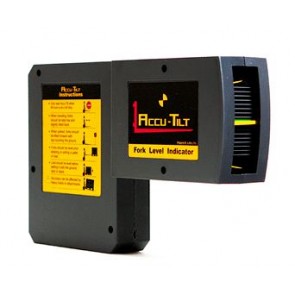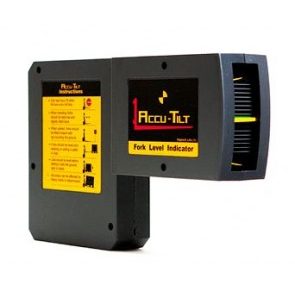Fork Angle Is Critical Information
 When using a forklift to lift and move pallets of materials, pieces of heavy equipment, or other bulk loads, there are a number of pieces of critical information that the operator needs to know. These include the weight of the load, how the load is secured, and its center of gravity.
When using a forklift to lift and move pallets of materials, pieces of heavy equipment, or other bulk loads, there are a number of pieces of critical information that the operator needs to know. These include the weight of the load, how the load is secured, and its center of gravity.
But a fourth piece of information is equally important: The angle of the forks when the load is raised. This is especially true when the forklift operator can’t visually see where the load is being placed, such as when it is being put on raised racks or a high shelf in a warehouse or dock.
A fork tilt level indicator can provide this essential information, allowing forklift driver to move and place even the biggest, bulkiest, and heaviest loads perfectly every time.
Understanding the Payload
Most forklift jobs are routine: The driver picks up a pallet loaded with materials and moves it from one place to another. But there are other tasks that offer more challenges. And one wrong move — or not having adequate or correct information about the payload — can have tragic consequences.
For example, the weight of what the driver is lifting is important to know. If the weight exceeds the forklift’s lifting capacity, it can cause a tip-over accident. Or it may result in the forklift failing and the load falling to the ground below.
Similarly, the load’s center of gravity matters. If the load is top-heavy, for example, it is more likely to tilt or fall during transport.
How the load is secured also matters. If the pallet is wrapped in plastic sheeting or nylon straps there is less likelihood of items falling off the pallet in transit. But if the load is inadequately secured or not secured at all, even the slightest bump or sharp turn can cause the driver to spill his load.
Critical Data
Information about the load is critical. But so is the angle of the forks when lifting and moving the load. If the angle is forward, there is a real possibility of the pallet sliding off the vehicle’s forks.
Fork angle also is critical to know when loading a pallet or another load on a high shelf or rack. The driver can’t always physically see the angle. So the risk of hitting the shelf during loading or placing the pallet or load improperly is high.
A simple solution is a tilt level indicator. These convenient forklift accessories let the operator know the angle of the vehicle’s forks at all times. They take the guesswork out of lifting and moving loads, regardless of the weight, size, or height of the job.
Some forklifts come with tilt level indicators built in. For others, they are available as aftermarket accessories that can be quickly and simply installed on practically any forklift.
Whenever lifting or moving any payload, having all the critical information you need to complete the job safely is key. Forklift tilt angle indicators provide the final, crucial piece of information you need to get the job done right.

